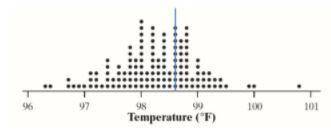
Advanced Placement (AP), 22.03.2021 08:40 SakChan8367
Do You Have a Fever? Sometimes when you’re sick, your forehead feels really warm. You might have a fever. How can you find out whether you do? By taking your temperature, of course. But what temperature should the thermometer show if you’re healthy? Is this temperature the same for everyone?
Several years ago, researchers conducted a study to determine whether the “accepted” value for normal body temperature, 98.6°F, is accurate. They used an oral thermometer to measure the temperatures of a random sample of healthy men and women aged 18 to 40. As is often the case, the researchers did not provide their original data.
Allen Shoemaker, from Calvin College, produced a data set with the same properties as the original temperature readings. His data set consists of one oral temperature reading for each of 130 randomly chosen, healthy 18- to 40-year-olds.1 A dotplot of Shoemaker’s temperature data is shown below. We have added a vertical line at 98.6°F for reference.
Exploratory data analysis revealed several interesting facts about this data set:
• The mean temperature was x=98.25F.
• The standard deviation of the temperature readings was sx = 0.73°F.
• 62.3% of the temperature readings were less than 98.6°F.
Based on the results of the study, can we conclude that “normal” body temperature in the population of healthy 18-to-40-year-olds is not 98.6°F?
Case Closed
1. If “normal” body temperature really is 98.6°F, we would expect that about half of all healthy 18- to 40-year-olds will have a body temperature less than 98.6°F. Do the data from this study provide convincing evidence at the α = 0.05 level that this is not the case?
2. The test in Question 1 has power 0.66 to detect that the actual population proportion is 0.60. Describe two changes that could be made to increase the power of the test.
Do the data provide convincing evidence that average normal body temperature is not 98.6°F? The computer output below shows the results of a one-sample t test and a 95% confidence interval for the population mean μ.
[One-Sample T image goes here]
3. What conditions must be satisfied for a one-sample t test to give valid results? Show that these conditions are met in this setting.
4. Explain how the P-value and the confidence interval lead to the same conclusion for the significance test.
5. Based on the conclusion in Question 4, which type of error could have been made: a Type I error or a Type II error? Justify your answer.



Answers: 2


Another question on Advanced Placement (AP)

Advanced Placement (AP), 27.06.2019 16:50
Ineed somebody to solve the multiple choice questions for the california real estate exam ?
Answers: 2

Advanced Placement (AP), 28.06.2019 05:00
Hurry plz answer the y-intercept of a parabola is 1, and its vertex is at (1,0). what function does the graph represent? a. f(x) = (x − 1)2 b. f(x) = (x + 1)2 c. f(x) = -1(x − 1)2 d. f(x) = -1(x + 1)2
Answers: 1

Advanced Placement (AP), 28.06.2019 17:30
Can you me with this question? i don’t understand.
Answers: 1

Advanced Placement (AP), 28.06.2019 18:00
Latoya who experiences severe depression was recruited fro a research study in which she will recieve either an antidepressanr or an active plaecebo. latoya recieves the active placebo. compared with people recieving the active drug, latoya will
Answers: 1
You know the right answer?
Do You Have a Fever? Sometimes when you’re sick, your forehead feels really warm. You might have a f...
Questions


Mathematics, 05.06.2020 19:58


Mathematics, 05.06.2020 19:58

Mathematics, 05.06.2020 19:58

English, 05.06.2020 19:58



English, 05.06.2020 19:58

Mathematics, 05.06.2020 19:58



Mathematics, 05.06.2020 19:58

Health, 05.06.2020 19:58

Mathematics, 05.06.2020 19:58

Mathematics, 05.06.2020 19:58


Mathematics, 05.06.2020 19:59

Mathematics, 05.06.2020 19:59

Mathematics, 05.06.2020 19:59



